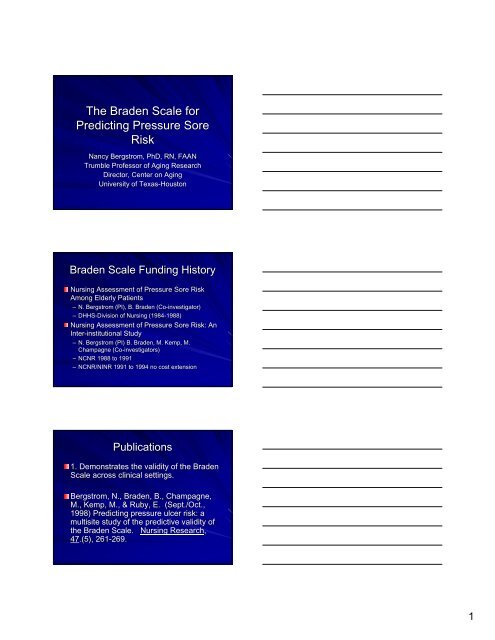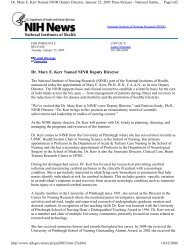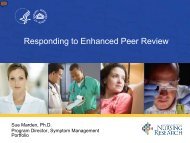The Braden Scale for Predicting Pressure Sore Risk - National ...
The Braden Scale for Predicting Pressure Sore Risk - National ...
The Braden Scale for Predicting Pressure Sore Risk - National ...
Create successful ePaper yourself
Turn your PDF publications into a flip-book with our unique Google optimized e-Paper software.
<strong>The</strong> <strong>Braden</strong> <strong>Scale</strong> <strong>for</strong><br />
<strong>Predicting</strong> <strong>Pressure</strong> <strong>Sore</strong><br />
<strong>Risk</strong><br />
Nancy Bergstrom, PhD, RN, FAAN<br />
Trumble Professor of Aging Research<br />
Director, Center on Aging<br />
University of Texas-Houston<br />
<strong>Braden</strong> <strong>Scale</strong> Funding History<br />
Nursing Assessment of <strong>Pressure</strong> <strong>Sore</strong> <strong>Risk</strong><br />
Among Elderly Patients<br />
– N. Bergstrom (PI), B. <strong>Braden</strong> (Co-investigator)<br />
– DHHS-Division Division of Nursing (1984-1988)<br />
1988)<br />
Nursing Assessment of <strong>Pressure</strong> <strong>Sore</strong> <strong>Risk</strong>: An<br />
Inter-institutional Study<br />
– N. Bergstrom (PI) B. <strong>Braden</strong>, M. Kemp, M.<br />
Champagne (Co-investigators)<br />
– NCNR 1988 to 1991<br />
– NCNR/NINR 1991 to 1994 no cost extension<br />
Publications<br />
1. Demonstrates the validity of the <strong>Braden</strong><br />
<strong>Scale</strong> across clinical settings.<br />
Bergstrom, N., <strong>Braden</strong>, B., Champagne,<br />
M., Kemp, M., & Ruby, E. (Sept./Oct.,<br />
1998) <strong>Predicting</strong> pressure ulcer risk: a<br />
multisite study of the predictive validity of<br />
the <strong>Braden</strong> <strong>Scale</strong>.<br />
Nursing Research,<br />
47.(5), .(5), 261-269.<br />
269.<br />
1
Publications (continued)<br />
2. Demonstrates that without assessment,<br />
treatments are not done.<br />
Bergstrom, N., <strong>Braden</strong>, B., Kemp, M.,<br />
Champagne, M., & Ruby, E. (1996). Multi-site<br />
study of incidence of pressure ulcers and the<br />
relationship between risk level, demographic<br />
characteristics, diagnoses, and prescription of<br />
preventive interventions. Journal of the<br />
American Geriatric Society, , 44. 22-30.<br />
Publications (continued)<br />
3. Demonstrates that the cut off points are<br />
the same <strong>for</strong> Black & White subjects.<br />
Bergstrom, N., <strong>Braden</strong>, B.J.<br />
(2002). Predictive Validity of the <strong>Braden</strong><br />
<strong>Scale</strong> Among Black and White Subjects.<br />
Nursing Research, , 51 (6), 398-403.<br />
Conceptual Schema <strong>for</strong> Etiologic Factors in<br />
<strong>Pressure</strong> <strong>Sore</strong> Development<br />
Mobility<br />
Intensity & Duration<br />
of <strong>Pressure</strong><br />
<strong>Pressure</strong> <strong>Sore</strong><br />
Development<br />
Tissue Tolerance<br />
Activity<br />
Sensory Perception<br />
Extrinsic Factors<br />
Moisture<br />
Friction & Shear<br />
Intrinsic Factors<br />
Nutrition<br />
Aging<br />
Low arteriolar pressure<br />
Low oxygen tension<br />
2
<strong>The</strong> <strong>Braden</strong> <strong>Scale</strong><br />
6 Subscales<br />
<strong>Pressure</strong> exposure<br />
– mobility, activity, sensory perception,<br />
Tissue tolerance<br />
– moisture, friction & shear, nutrition<br />
6-23 points<br />
<strong>The</strong> Purpose of <strong>Risk</strong><br />
Assessment is to:<br />
Reduce the incidence of pressure ulcers<br />
Identify who is and who is not at risk<br />
Plan care based on risk factors and level<br />
of severity of risk factors<br />
Avoid unnecessary expensive care<br />
Improve quality of care and decrease<br />
costs<br />
Questions to Answer<br />
Is the tool valid and reliable?<br />
What is the critical cut-off point?<br />
Is the cut-off point different across the<br />
system? (tertiary care, nsg home)<br />
When should assessment be done?<br />
Is reassessment necessary?<br />
3
Purpose<br />
Evaluate the predictive validity of the<br />
<strong>Braden</strong> <strong>Scale</strong> across settings<br />
– What is the critical cutoff point <strong>for</strong> classifying<br />
risk in specific settings<br />
– What is the optimal timing <strong>for</strong> assessing risk<br />
across settings?<br />
Tertiary Care<br />
VAMC<br />
SNF<br />
Settings<br />
Omaha - 382 beds (290 acute), level I trauma<br />
Chicago - 903 major referral center<br />
Omaha -<br />
MN)<br />
Raleigh -<br />
226 level II (NE, KS, MO, IA, ND, SD,<br />
382 level I (NC & East TN)<br />
Omaha – 250 bed with 126 extended care<br />
Raleigh – 120 SNF affiliated with VAMC<br />
Subjects<br />
New admissions list<br />
Randomly selected<br />
Verbal consent (quality improvement<br />
assumption with nursing assessment)<br />
Subjects over 19 years<br />
New admissions within 72 hours<br />
No pressure ulcers<br />
4
Staff training<br />
Videos created<br />
– <strong>Braden</strong> <strong>Scale</strong><br />
– <strong>Pressure</strong> Ulcer training<br />
Staff View videos<br />
Vingettes<br />
Patient ratings/inter rater reliability<br />
Procedures<br />
<strong>Risk</strong> assessment by study RN<br />
– Admission<br />
– Q 48-72 hours (M-W-F)<br />
Skin assessment by another RN<br />
Admission<br />
Q 48 -72 hours<br />
Blind to the other assessment<br />
Must have 2 assessments<br />
Critical Cut-Off (Tertiary)<br />
Score<br />
18<br />
SE<br />
SP<br />
PVP<br />
PVN<br />
%<br />
Time 1<br />
38<br />
79<br />
14<br />
93<br />
75<br />
Time 2<br />
88<br />
68<br />
21<br />
99<br />
70<br />
5
Critical Cut-Off (SNF)<br />
Score<br />
18<br />
SE<br />
SP<br />
PVP<br />
PVN<br />
%<br />
Time 2<br />
72<br />
68<br />
42<br />
89<br />
69<br />
Ongoing<br />
81<br />
73<br />
50<br />
92<br />
75<br />
Prevention Without <strong>Risk</strong><br />
Assessment<br />
Prospective study (n=843)<br />
<strong>Risk</strong> assessed by research team<br />
No <strong>for</strong>mal assessment by caregivers<br />
Preventive practices observed<br />
Prescriptions <strong>for</strong> turning and support<br />
surfaces recorded<br />
Prevention Without <strong>Risk</strong><br />
Assessment<br />
Patient sorted into<br />
90<br />
risk categories<br />
80<br />
% receiving treatment<br />
70<br />
documented<br />
60<br />
50<br />
according to risk<br />
40<br />
– 0=no risk (>18)(<br />
30<br />
– 1=mild risk (16-18)<br />
18) 20<br />
– 2=mod risk (13-15)<br />
15) 10<br />
– 3= high risk (
Prescription of Turning by<br />
Gender and Level of <strong>Risk</strong><br />
100<br />
90<br />
80<br />
70<br />
60<br />
% 50<br />
40<br />
30<br />
20<br />
10<br />
0<br />
Male<br />
Female<br />
None Low Moderate High<br />
Prescription of Turning by Race<br />
and Level of <strong>Risk</strong><br />
90<br />
80<br />
70<br />
60<br />
50<br />
%<br />
40<br />
30<br />
20<br />
10<br />
0<br />
White<br />
Other<br />
None Low Moderate High<br />
Prescription of Turning by Age<br />
and Level of <strong>Risk</strong><br />
100<br />
90<br />
80<br />
70<br />
60<br />
% 50<br />
40<br />
30<br />
20<br />
10<br />
0<br />
75 & less<br />
76 plus<br />
None Low Moderate High<br />
7
Prevention Without <strong>Risk</strong><br />
Assessment<br />
As assessed risk level increased,<br />
interventions increased<br />
Support surfaces were prescribed more<br />
frequently than turning<br />
Women, white people and elderly more<br />
likely to have turning or support surfaces<br />
ordered<br />
Formal assessment levels the playing field<br />
of risk assessment<br />
Predictive Validity among Black<br />
and White Subjects<br />
Is the predictive validity similar <strong>for</strong> both<br />
Black and White Subjects<br />
Secondary analysis<br />
Predictive validity:<br />
Black versus white subjects<br />
Variable<br />
White<br />
Black<br />
Total<br />
Number<br />
666 (79%)<br />
159 (12%)<br />
843<br />
Stage 1<br />
32<br />
1<br />
33<br />
Stage 2<br />
66<br />
7<br />
73<br />
8
Sensitivity (SE), Specificity (SP),<br />
PVP, PVN, % Correct<br />
Race<br />
SE<br />
SP<br />
PVP<br />
PVN<br />
%<br />
Black<br />
75<br />
76<br />
17<br />
98<br />
76<br />
White<br />
70<br />
77<br />
41<br />
92<br />
75<br />
Differences by Race<br />
Receiver operator characteristics curve<br />
Area under curve<br />
– White 0.75, SE 0.03<br />
– Black 0.82, SE 0.07<br />
– Z = 0 .005 (not significantly different)<br />
Comparison with Mammography<br />
(SENS - 75%; SPEC – 92%; PVP 5%)<br />
SCORE SENS SPEC PVP PVN<br />
Med-Surg<br />
16 100 90 50 100<br />
Step-down<br />
16 100 64 61 85<br />
ICU 16 83 64 61 85<br />
SNF 18 81 73 50 92<br />
VAMC 18 70 79 30 96<br />
Tertiary 18 88 68 21 99<br />
Home Care 18 100 34 33 100<br />
9
LEVELS OF PRESSURE SORE RISK<br />
USING BRADEN SCALE<br />
MILD RISK 15-18<br />
18<br />
MODERATE RISK 13-14<br />
14<br />
HIGH RISK 10-12<br />
12<br />
VERY HIGH RISK > 9<br />
Incidence of Ulcers With <strong>Risk</strong><br />
Assessment Based Prevention<br />
Horn, Ashton, Tracy,<br />
l994.<br />
Decrease ulcers to<br />
near zero in ‘94 & ‘95<br />
Saved $1.2 million<br />
35<br />
30<br />
25<br />
20<br />
15<br />
10<br />
5<br />
0<br />
0 1 2 3 4<br />
92<br />
93<br />
<strong>Braden</strong> <strong>Scale</strong> Translations<br />
– Chinese<br />
– Japanese<br />
– Thai<br />
– Korean<br />
– Croatian<br />
– Icelandic<br />
– Dutch<br />
– French<br />
– Italian<br />
– German<br />
– Spanish<br />
– Portuguese<br />
Portugal<br />
Brazil<br />
10
Summary<br />
<strong>Risk</strong> assessment is done to determine<br />
required preventive measures<br />
A score of 18 is the cut-off <strong>for</strong> risk <strong>for</strong> most<br />
settings and subjects<br />
Clinical judgment must always supplement<br />
assessment<br />
Nancy.Bergstrom@uth.tmc.edu<br />
www.bradenscale.com<br />
THANK YOU<br />
BHP, DHHS; NCNR; NINR<br />
Colleagues: <strong>Braden</strong>, Champagne, Kemp<br />
Research staff….<br />
Clinical specialists who tested in their<br />
setting<br />
Everyone who helps to translate this into<br />
clinical use.<br />
Lois Graham, Lucile Lewis & Barbara<br />
Hansen<br />
11












